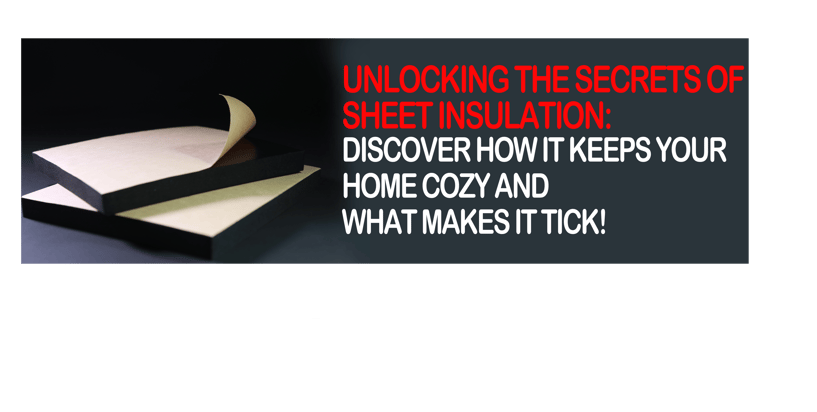
Unlocking the Secrets of Sheet Insulation
12/18/20235 min read


R-Value is a measure of the performance of insulating materials. Its core concept is the ability to hinder heat transfer. A higher R-Value means the insulation provides better insulation and is more effective at preventing the exchange of heat between indoors and outdoors.
From a home buyer's perspective, choosing insulation materials with a high R-Value can help improve the energy efficiency of the home, maintain a more comfortable temperature indoors, and reduce the loss of hot and cold air. In winter, high R-Value insulation material can prevent warm air from escaping and reduce heating costs; while in summer, it can effectively isolate the outside high temperature, reduce the use of air conditioners, and reduce cooling costs.
Categories
Popular
Where can I get high quality foam insulation sheets?
We have focused on the research of thermal insulation materials for forty years and have obtained many international certifications. We are mainly engaged in glass wool, thermal insulation rubber and plastic, rock wool and other products. Choose us to give you a satisfactory experience
If your home falls short on comfort, the solution might be closer than you think—Foam Board Insulation. Explore the potential of turning your space into a cozy haven. Discover how this innovative insulation can enhance your living experience! From open cavities to wall transformations, we'll guide you through the journey of achieving the perfect home ambiance. Ready to redefine your comfort zone?"


How Sheet Insulation Works?
Foam board insulation works by creating a barrier that impedes the transfer of heat. The insulation material, often composed of polystyrene, polyisocyanurate, or polyurethane, possesses low thermal conductivity, making it an effective thermal insulator.
The key mechanism involves slowing down the movement of heat through the material. The rigid panels trap air within their structure, and since air is a poor conductor of heat, it reduces the heat transfer between the inside and outside environments.
Foam board insulation also helps control moisture and vapor. Certain types may include a vapor barrier that prevents moisture from infiltrating the insulation, thereby averting potential issues like mold growth.
When installed in walls, ceilings, or floors, foam board insulation enhances the energy efficiency of buildings by minimizing heat loss in winter and heat gain in summer, contributing to a more comfortable and energy-efficient living or working space.
What is R-Value?
What is Sheet Insulation Made of?
The primary materials used in crafting foam board insulation are polystyrene, polyisocyanurate (polyiso), and polyurethane.
Polystyrene, as defined by the U.S. DOE, is a colorless, transparent thermoplastic. It comes in two main forms: molded expanded polystyrene, such as foam boards, and extruded polystyrene (XPS). Expanded polystyrene (EPS) and XPS are both derived from polystyrene, with EPS composed of fused plastic beads and XPS starting as molten material pressed into sheets.
Polyisocyanurate is a thermosetting plastic known for being a closed-cell foam, containing low-conductivity gas in its cells. Over time, polyisocyanurate may experience a decrease in R-Value as some of the low-conductivity gas escapes and is replaced by air.
Polyurethane, a foam insulation, can exist in either open-cell or closed-cell forms. Additionally, reflective foil, when positioned to face an open-air space, can function as a radiant barrier.
Sheet insulation consists of sturdy panels crafted from materials such as polystyrene, polyisocyanurate, and polyurethane, as outlined by the U.S. Department of Energy.
These versatile panels are designed to insulate various areas in your home, from top to bottom. Whether you're renovating and the drywall is removed or you're looking to enhance the insulation of open spaces in your pole barn, foam board proves to be a reliable solution."
Sheet insulation comes in an array of thicknesses, lengths, and facings, providing the flexibility to tailor it precisely to your project's needs. Certain foam board series even feature a white foil vapor barrier on both sides, acting as a protective shield against water infiltration and preventing the formation of mold.
What is Sheet Insulation?




Sheet Insulation's Pros and Cons
Pros:
Water Resistance: Rigid foam board insulation products are designed to be water-resistant, helping to minimize moisture accumulation in your home and reducing the risk of mold growth.
Environmentally Friendly Production: Expanded polystyrene board is the only foam board that doesn't utilize HCFCs (hydrochlorofluorocarbons) in its production, making it a more environmentally friendly option.
Cost-Effective: Expanded polystyrene board is among the most affordable foam board options available in the market.
DIY-Friendly Installation: The installation of foam boards can be a do-it-yourself project for experienced handymen, potentially saving on installation costs.
Cons:
Joint Sealing Required: The joints between sheets and boards must be properly taped or caulked to prevent unwanted airflow into your home.
Custom Cutting: Foam boards must be custom-cut to fit the specific area of installation, adding to the installation complexity.
Moisture Collection: Expanded polystyrene boards may have air bubbles that can impede heat transfer but may also collect moisture, potentially rendering them less effective in preventing mold and mildew growth.
Potential Decrease in Insulating Abilities: Polyisocyanurate foam boards might experience a decline in insulating abilities over time.
Cost Consideration: Rigid foam boards tend to be slightly more expensive than traditional insulation materials.
















About Us
Click the button below to get more information about us
Newsletter
Click to subscribe for more information
Follow Us
Contact Us
Address
Dacheng town, Langfang City, Hebei province, China
Phone
+86 185 03165 626
